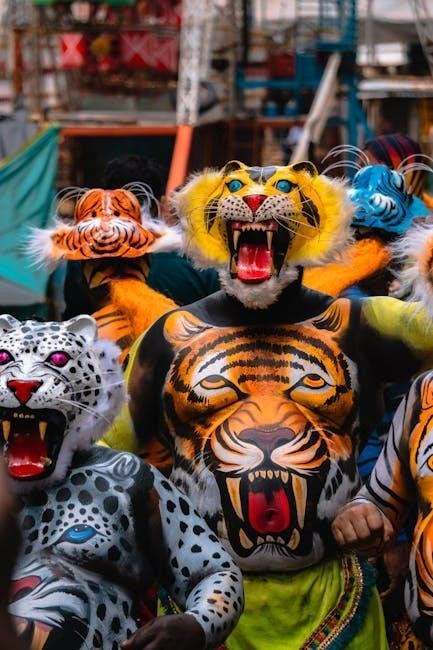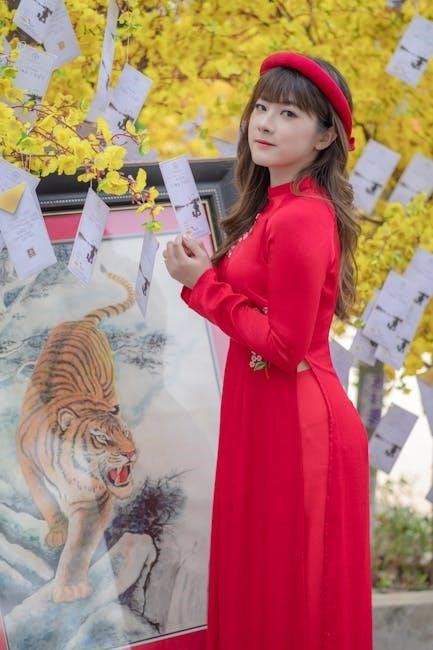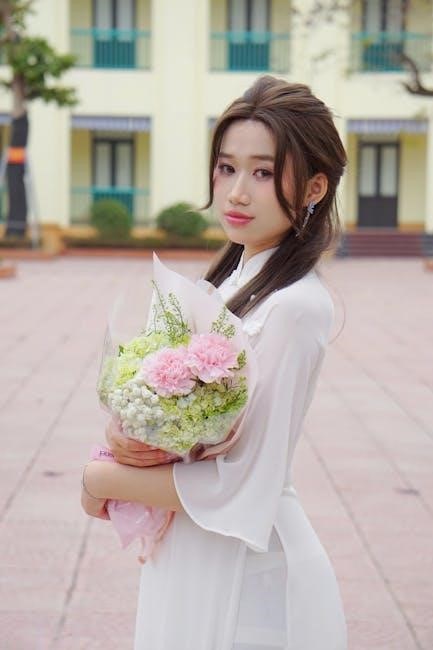The story by Frank R. Stockton explores themes of love, jealousy, and justice in a semi-barbaric kingdom. It is available as a free PDF via Project Gutenberg.
1.1 Overview of the Short Story
Frank R. Stockton’s “The Lady, or the Tiger?” is a 19th-century short story set in a semi-barbaric kingdom. It revolves around a unique justice system where prisoners choose between two doors, one revealing a tiger and the other a lady. The princess’s love for a young man leads to a dramatic trial, ending in ambiguity. The story is available in PDF format through Project Gutenberg and other online sources.
1.2 Importance of the Story in Literature
Frank R. Stockton’s “The Lady, or the Tiger?” is a landmark in American literature, celebrated for its exploration of human emotions and moral dilemmas. Its unique narrative structure and unresolved ending have sparked enduring debates, making it a significant piece in literary studies. The story’s availability in PDF formats through platforms like Project Gutenberg ensures its continued accessibility and impact on readers and scholars alike.
Historical Background of the Story
Published in 1882, the story is set in a semi-barbaric kingdom, reflecting themes of justice and morality. Its public domain status ensures accessibility via platforms like Project Gutenberg.
2.1 The Semi-Barbaric Kingdom Setting
The tale unfolds in a semi-barbaric kingdom, blending primitive customs with refined influences. The ruler’s elaborate justice system showcases a society both brutal and sophisticated, providing a unique backdrop for the story’s moral dilemmas. This setting highlights the clash between barbarism and civilization, enriching the narrative’s exploration of human nature and justice. The kingdom’s duality is central to the story’s themes.
2.2 The King’s Unique Justice System
The king’s justice system is both brutal and theatrical, using an arena where prisoners choose between two doors. One door leads to a ferocious tiger, symbolizing death, while the other reveals a lady, offering marriage. This method, while seemingly fair, reflects the king’s flair for drama and control, blending spectacle with ruthless efficiency. The system embodies the kingdom’s semi-barbaric nature and the king’s authoritarian rule.
Themes Explored in the Story
Love, jealousy, and the complexity of choice are central themes, highlighting the human heart’s turmoil and moral dilemmas in a semi-barbaric society.
3.1 Love and Jealousy
The story delves into the intense love between the princess and the young man, complicated by her overwhelming jealousy. Her emotions drive the plot, as she must choose between saving him and eliminating her rival, showcasing the destructive power of jealousy and the redemptive potential of love in a tense moral conflict.
3.2 Justice and Fairness
The king’s unique justice system tests guilt or innocence through a perilous choice, raising questions about fairness. The story critiques the notion of impartial justice, as personal bias and emotion influence decisions, highlighting the tension between arbitrary fate and true fairness in a semi-barbaric society.
3.3 The Nature of Choice
The story delves into the complexities of choice, particularly the princess’s dilemma. Her decision reflects the human struggle between love and jealousy, illustrating how personal emotions can override logic. The narrative challenges readers to consider the moral implications of their choices, emphasizing the profound impact of decisions made under intense emotional pressure.

Key Elements of the Story
The princess’s role, the trial arena, and the moral dilemmas form the core of the narrative, available for readers to explore in its PDF format.
4.1 The Princess’s Role
The princess plays a pivotal role, navigating love, jealousy, and moral conflict. She uses her influence to uncover the secrets behind the doors, deciding the young man’s fate. Her actions highlight the story’s exploration of human emotions and ethical dilemmas, all while maintaining the kingdom’s justice system. Her character embodies the complexity of love and power, central to the narrative’s tension and themes.
4.2 The Trial Arena and Its Significance
The trial arena symbolizes the king’s unique justice system. It is a place where fate is decided, with one door revealing a lady and the other a tiger. This setting emphasizes the story’s central themes of choice, justice, and the human condition. The arena serves as a dramatic backdrop for the moral and emotional conflicts faced by the characters.

The Princess’s Dilemma
The princess faces a heart-wrenching choice: save her lover by revealing the tiger’s door or sacrifice him due to jealousy over the lady behind the other door.
5.1 Her Love for the Young Man
The princess’s deep love for the young man fuels her desire to save him. Her affection drives her to gather crucial information about the trial, ensuring his survival. This love becomes the central motive behind her actions, highlighting the strength of her emotions and devotion.
5.2 The Moral and Emotional Conflict
The princess faces a profound moral and emotional conflict, torn between saving her lover and her intense jealousy. She knows behind one door lies death by a tiger, and behind the other, a lady who could marry the man she loves. Her decision reflects the complexity of human emotions, where love and jealousy intertwine, creating a deeply personal and ethical dilemma.

The Trial System
The trial system involves two doors, one revealing a lady and the other a tiger, determined by the king’s unique justice method, testing guilt or innocence.
6.1 The Doors: Lady vs. Tiger
The doors represent a choice between life and death. One door hides a beautiful lady, the other a ferocious tiger. The accused must choose blindly, fate decided instantly. This method tests guilt or innocence through chance, a unique justice system designed by the king to maintain fairness and fear in his kingdom.
6.2 The King’s Method of Justice
The king’s justice system relies on chance and spectacle. Criminals face a public trial in an arena with two doors: one reveals a lady for marriage, the other a tiger for death; The choice is random, symbolizing fate’s role in justice. This unique method combines punishment with entertainment, emphasizing the king’s belief in divine or random judgment to determine guilt or innocence publicly.
Symbolism in the Story
The tiger symbolizes danger and punishment, while the lady represents love and societal expectations, highlighting the clash between passion and justice in the kingdom’s brutal system.
7.1 The Tiger as a Symbol of Danger
The tiger symbolizes imminent danger and ruthless punishment in Frank R. Stockton’s “The Lady, or the Tiger?”. Its ferocity and hunger embody the fear of death, contrasting sharply with the lady’s representation of love. This duality highlights the brutal justice system of the semi-barbaric kingdom, underscoring the deadly consequences that await the accused.
7.2 The Lady as a Symbol of Love
The lady symbolizes love, grace, and hope in “The Lady, or the Tiger?”. She represents the possibility of romance and redemption, embodying the human desire for connection and happiness. Her presence in the story contrasts sharply with the tiger’s danger, highlighting the emotional and moral dilemmas faced by the characters in the semi-barbaric kingdom’s justice system.

Legacy and Impact of the Story
“The Lady, or the Tiger?” remains Frank R. Stockton’s most celebrated work, influencing literature and culture. Its exploration of human nature continues to captivate readers, available as a free PDF on platforms like Project Gutenberg.
8.1 Cultural and Literary Influence
Frank R. Stockton’s “The Lady, or the Tiger?” has left a lasting impact on literature and culture. First published in 1882, it remains a celebrated work, exploring themes like love, jealousy, and justice. Its unique narrative has inspired adaptations and discussions, making it a timeless classic. The story’s availability as a free PDF on platforms like Project Gutenberg has furthered its reach, ensuring its influence endures in modern literature and popular culture.
8.2 Adaptations and Sequels
Frank R. Stockton’s “The Lady, or the Tiger?” has inspired various adaptations, including films, stage plays, and sequels. Stockton himself wrote a sequel, “The Discourager of Hesitancy,” continuing the narrative. The story’s enduring appeal has led to numerous reinterpretations, further cementing its place in literary history. Its availability in PDF format has made it accessible to modern readers, ensuring its influence persists across generations and mediums.

Availability in PDF Format
“The Lady, or the Tiger?” by Frank R. Stockton is freely available in PDF format through platforms like Project Gutenberg, ensuring easy access for readers worldwide.
9.1 Sources for Download
The Lady, or the Tiger? is available for free download in PDF format from reputable platforms like Project Gutenberg and the Internet Archive. Additionally, educational sites such as CommonLit offer downloadable versions for classroom use. These sources ensure easy and legal access to the story, making it widely accessible to readers and students worldwide.
9.2 Free Access Through Project Gutenberg
Project Gutenberg offers a free eBook version of The Lady, or the Tiger?, allowing readers to download the story in PDF format without any cost or restrictions. This platform ensures that Stockton’s classic tale remains accessible to everyone, preserving its literary legacy for future generations. Visit www.gutenberg.net to access the full text legally and effortlessly.
The Lady, or the Tiger? by Frank R. Stockton remains a timeless tale of love, jealousy, and justice. Its enduring relevance and availability in PDF ensure its continued impact on readers worldwide.
10.1 Summary of Key Points
The Lady, or the Tiger? by Frank R. Stockton is a captivating tale set in a semi-barbaric kingdom, exploring themes of love, jealousy, and justice. The story revolves around a princess’s agonizing choice between saving her lover or allowing a tiger to decide his fate. Its unique trial system and emotional depth have made it a literary classic, with the full text available as a free PDF on platforms like Project Gutenberg.
10.2 Final Thoughts on the Story’s Relevance
The Lady, or the Tiger? remains a timeless exploration of human emotions, justice, and morality. Its enduring popularity lies in its ability to provoke thought about choice and consequence. The story’s themes are universally relevant, making it a valuable resource for literary studies and discussions on ethics. Its availability as a free PDF ensures its continued accessibility for future generations of readers and scholars alike.
Character Analysis
The story’s characters include the princess, the young man, and the semi-barbaric king. The princess’s love and jealousy drive the plot, while the king’s justice system adds complexity.
11.1 The Semi-Barbaric King
The king, a complex figure, blends barbaric instincts with refined ideas. His justice system, a public spectacle, forces choices between life and death. This method reflects his dual nature, emphasizing both cruelty and theatricality, while shaping the princess’s moral conflict.
11.2 The Young Man and the Princess
The young man, a lover of the princess, faces a deadly trial, while she grapples with love and jealousy. Her discovery of the trial’s setup forces a moral choice: save him or let him face the tiger. Her decision, driven by devotion and rivalry, highlights the story’s central conflict and emotional depth, leaving the outcome famously unresolved.

Educational Use of the Story
The story is widely used in classrooms to teach themes, morals, and critical thinking, with its unresolved ending sparking discussions on justice and human nature.
12.1 Teaching Themes and Morals
The story effectively teaches themes of love, jealousy, and justice, encouraging students to reflect on moral dilemmas. Its unresolved ending prompts discussions on fairness and human nature, fostering critical thinking. Educators use the narrative to explore complex emotions and ethical decisions, making it a valuable tool for character development and moral education in classrooms.
12.2 Encouraging Critical Thinking
The story’s cliffhanger ending and moral dilemmas prompt students to analyze themes and outcomes, fostering critical thinking. Educators use the narrative to engage students in discussions about justice, love, and consequences, encouraging them to evaluate evidence and form reasoned opinions. The unresolved conclusion challenges students to think deeply about human behavior and ethical decision-making.
